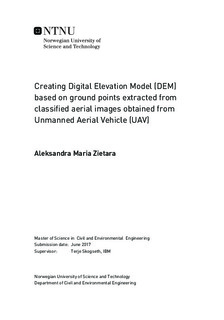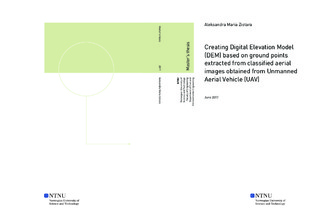| dc.description.abstract | With an advent of Unmanned Aerial Vehicles (UAV) and attempts to use them as devices to collect information about terrain, the discussion about the quality of derived products and possibilities of their further use in geomatics applications has begun. One of the desired outputs is the Digital Elevation Model (DEM) which represents the bare-earth surface. To obtain DEM from drone images, the point cloud needs to be filtered in order to remove all the points which are situated above the earth s surface. Most of the available software packages accomplish this with algorithms performing classification on point cloud. Outcomes are often not satisfactory, which results in erroneous DEM.
As an alternative solution, the author proposes image classification. The aim of the thesis is to examine the potential of image classification and judge if it could be a satisfying alternative for point cloud classification. Also, the capabilities of consumer-grade drone and drone-dedicated software are going to be evaluated.
The first step in the project workflow is capturing data with the use of Phantom 3 Advanced. The photogrammetric flight is prepared having regard to drone specifications, law regulations, and objective of the survey. After the flight, the photos are processed with the use of Agisoft PhotoScan and Pix4D Mapper. Root Mean Square (RMS) for Control Points are 6.12 cm for Pix4D and 7.91 for Agisoft, which are satisfying results. Dense point clouds, DEMs and orthophotomaps are generated and point cloud classification is performed. As the orthophotomap from Pix4D has better resolution, it is adopted for the process of image classification. This one is performed in ArcGIS Pro software and four classification algorithms are examined in order to choose the best one for this project. The highest accuracy is obtained by Random Trees supervised classifier (76%). Manual improvements are implemented and the map is reclassified into two classes: ground and non-ground objects. Next, the ground class is overlapped with the point cloud and points representing ground are used to generate Digital Elevation Model. DEM obtained from image classification is compared with DEM obtained from point cloud classification. For significant part of the study area the difference is smaller than 0.5 m, but for both models, problematic regions appear in the proximity of buildings and trees.
The thesis presents the potential of image classification method and improvements suggested in the last chapter can be adopted for further research of the topic. | |

